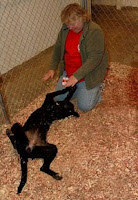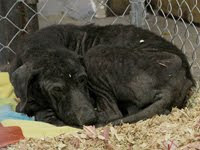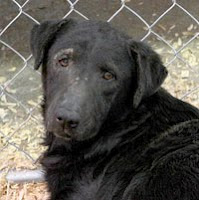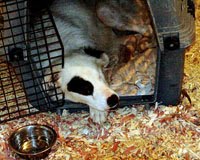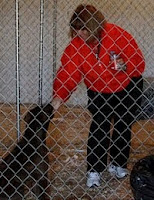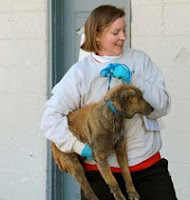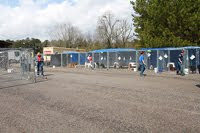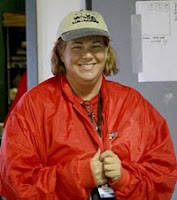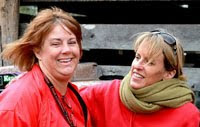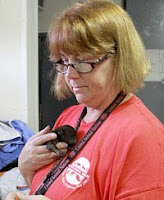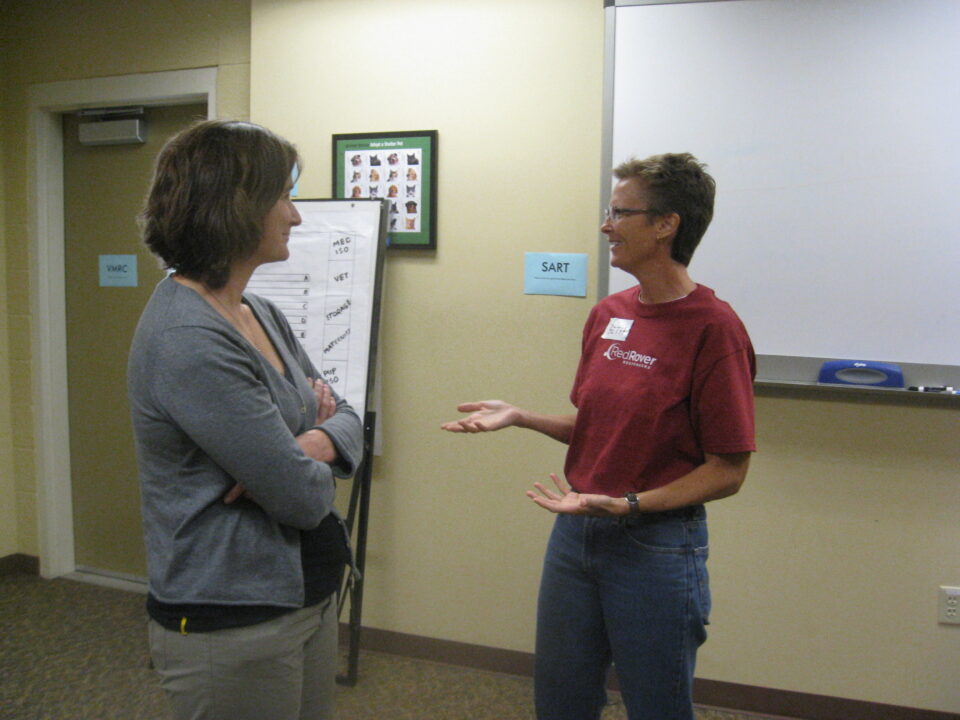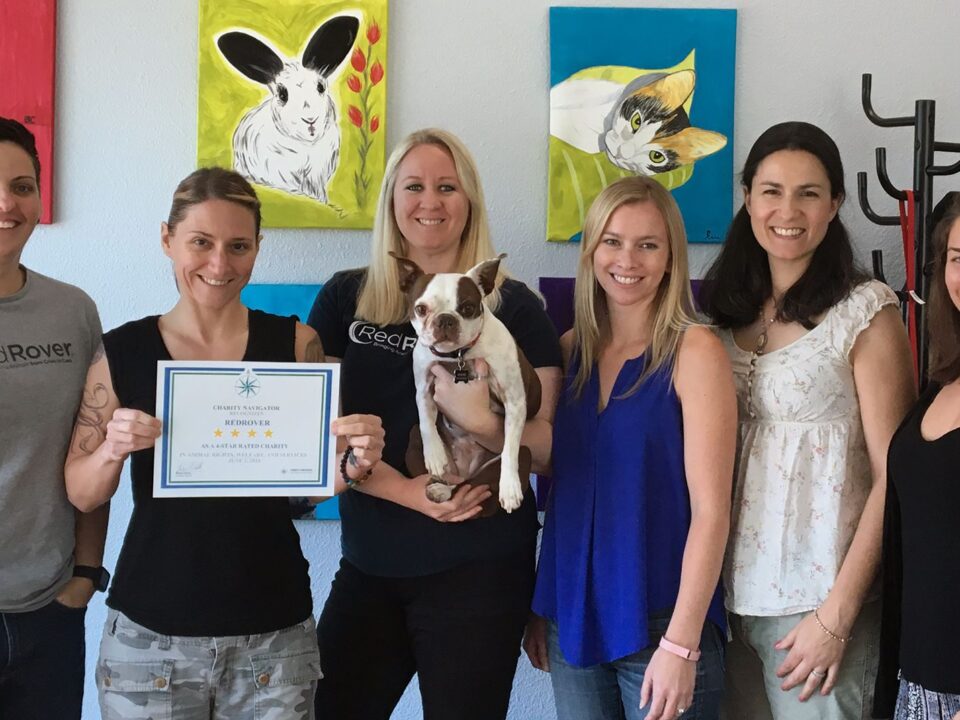Starting to wind down
March 15th, 2010
Submitted by EARS volunteer Marcia Goodman of Cromwell, Connecticut
Deploying for emergency animal sheltering is like walking into a different reality. One day you’re home with family and household animal companions and the next day you’re with animal rescue folks you haven’t seen in a long time or maybe have never before met. You all build the shelter and develop new bonds with the other volunteers or renew old ones as you tighten nuts on bolts. Then the animals arrive and you’re an animal sheltering team that works like clockwork to get the feeding, watering and cage cleaning done every day.
The same feeling of changing realities happens at emergency shelters as the needs shift over time. Animals leave, volunteers change, and you suddenly realize that your fellow volunteers are an entirely different crew of people from the day you arrived, and now you have a whole different sheltering experience – in this case the reduction in the number of dogs from 185 to fewer than 25 in the course of a day.
I am writing this on Saturday, the fourth day since the animals arrived, though it feels like so much longer! Since the HSUS rig left yesterday taking about 100 dogs, our work day has changed significantly. Feeding, watering and cleaning goes by very quickly, and we have lots of time for socializing these dogs who so much need the socialization – they are sweet and have apparently never had the positive attention we’ve been giving them.
The volunteers have given every dog a name, and we’ve been learning their personalities, which are so diverse. One dog, Sophie (above, with Lynn Covington), wants belly rubs 110 percent of the day. Hope (right), a very skinny girl who is the only one we feed three times a day because of her weight, is getting much more social, thanks in large part to the loving attention that new volunteer Janet Roush from Nebraska has been giving her.
Sweetie Girl (right), the dog I named, although shy, will now come over to you if you sit near her in her pen. Rufus (below right with Stacey Harris) is Mister Energy and is also a very social fellow; he may have had some training because if you have a little patience, he will sit for treats. Stevie (below left), a blind dog, is still frightened, but has made progress thanks in large part to the attention given him by Lynn Frischmann of California. We now see his nose and one paw nudge out of his kennel during the day, which never used to happen, and we know that he comes out of the kennel at night because we see his poop in his pen. We have a number of pens outdoors, and we’ve been moving dogs around this morning so they have a better opportunity to socialize with each other.
Today we’re featuring two volunteers who left yesterday. Ruth Scroggin came from Arkansas for this deployment. She has deployed with HSUS as well as UAN, and this is her fifth or sixth deployment. Ruth volunteers with EARS because “It’s well run and they value their volunteers and recognize the valuable work that volunteers do in the organization.”
I asked Ruth (pictured at right) what draws her to helping animals. She says that she wants to give a voice to the voiceless. Her background in sheltering includes cruelty investigations for a local humane society. Emergency animal sheltering is an extension of that.
Ruth has been a self-starter at this deployment – she sees a need and jumps right in, following all the appropriate protocols. She says that as you gain more experience, you get past the point of waiting to be told what to do. You need a watchful eye to take care of the animals’ needs here.
One way in which this deployment is similar to most others, Ruth told me, is in the appreciation by the local people for what we’ve done. That’s very special, she says. She always leaves an area appreciating the kindness of strangers. She recalls that during the Hurricane Katrina deployment, two elderly people offered their home to 12 volunteers, and cooked for them as well as housing them. The generous spirit of others is very special. As much as you give, you get back.
Another feature of these deployments that Ruth enjoys is how the volunteer teams have included a wide variety of animal specialists, including wildlife rehabilitators, EMT personnel, rescue transporters and so on.
The other volunteer who is leaving today is Regional Director Stacy Harris who led this shelter operation for UAN. Stacy has been an amazing leader, managing the operation in her low-key way. We were all particularly impressed when, after learning that the number of dogs arriving that day would be 185 instead of 80 to 100, she and her equally amazing counterpart from HSUS, Melissa Folberg, assembled the volunteer crew to erect a very large courtyard in the back filled with pens (at right). It seemed as if suddenly from nothing emerged a Doggie City. Major kudos to Stacy and Melissa for that and so much else!
Stacy has been Regional Director of UAN since 2008. She’s been on about six deployments, all with UAN. What drew her to animal rescue? It was sort of through a side door. She worked as a court-appointed Special Advocate for children who have been abused and neglected. A teenager she was representing loves animals and wanted to volunteer at the shelter but because of her age, needed an advocate. So, Stacey started volunteering with her. Three months later, the teenager stopped volunteering, but Stacey was hooked. Hurricane Katrina took Stacey into emergency animal work even more: her shelter took in nearly 100 dogs, and Stacey worked with them. Her mother lost her home in Katrina, and helping the dogs made Stacey feel that she was doing something important. She found that it was a double positive — she was helping animals and also helping people who needed the comfort of knowing that their household companions were being well cared for.
Stacey became involved with UAN when the EARS volunteer training workshop was offered to the staff and volunteers at her shelter. She went on one deployment as a regular volunteer, and then the position of Regional Director for her area opened up, and Stacey applied. Since her day job as a banker involves managing people, it seemed like a great fit, and she’s happy she’s gone that route, although she does miss that she doesn’t have time now to bond with the animals. (At right, Stacey is saying “good-bye” to UAN Emergency Services Manager Janell Matthies.)
At first Stacey was deployed only in natural disasters, but her last three deployments were man-made crises: dogfighting, a puppy mill and this hoarding situation. She sees volunteering for UAN as a way for her to deliver these animals from a horrible life. Her favorite part of any deployment is loading the dogs into transport vehicles when they’re ready to leave the emergency shelter for a new chance at a good life. Stacey is pictured at right with Melissa Folberg of HSUS.
Stacy says that her team at De Kalb has been great, and also points out that in her deployments with UAN, having great teams has been the norm. I think I can speak for the entire team here in De Kalb that we hope to have many more opportunities to work with Stacey in our future deployments.

